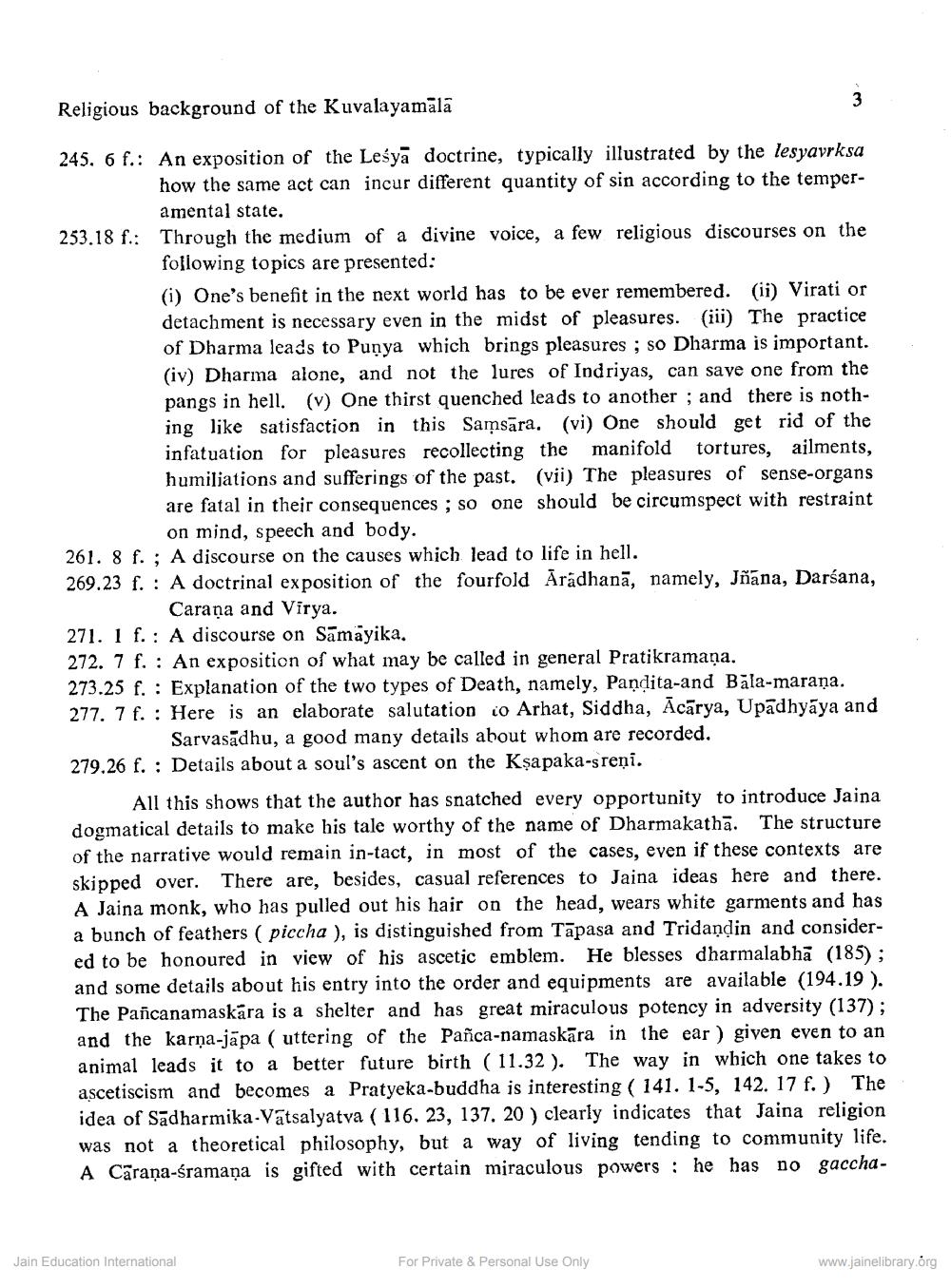Book Title: Religious background of Kuvalayamala Author(s): A N Upadhye Publisher: Z_Jinvijay_Muni_Abhinandan_Granth_012033.pdf View full book textPage 3
________________ Religious background of the Kuvalayamālā 245. 6 f.: An exposition of the Lesya doctrine, typically illustrated by the lesyavrksa how the same act can incur different quantity of sin according to the temper amental state. 253.18 f. Through the medium of a divine voice, a few religious discourses on the following topics are presented: 261. 8 f.; A discourse on the causes which lead to life in hell. 269.23 f. 3 (i) One's benefit in the next world has to be ever remembered. (ii) Virati or detachment is necessary even in the midst of pleasures. (iii) The practice of Dharma leads to Punya which brings pleasures; so Dharma is important. (iv) Dharma alone, and not the lures of Indriyas, can save one from the pangs in hell. (v) One thirst quenched leads to another; and there is nothing like satisfaction in this Samsara. (vi) One should get rid of the infatuation for pleasures recollecting the manifold tortures, tortures, ailments, humiliations and sufferings of the past. (vii) The pleasures of sense-organs. are fatal in their consequences; so one should be circumspect with restraint on mind, speech and body. 271. 1 f. 272. 7 f. 273.25 f. 277. 7 f. A doctrinal exposition of the fourfold Aradhana, namely, Jñana, Darśana, Carana and Virya. A discourse on Samayika. An exposition of what may be called in general Pratikramaņa. Explanation of the two types of Death, namely, Pandita-and Bala-marana. Here is an elaborate salutation to Arhat, Siddha, Acarya, Upadhyaya and Sarvasidhu, a good many details about whom are recorded. 279.26 f. Details about a soul's ascent on the Kṣapaka-sreni. All this shows that the author has snatched every opportunity to introduce Jaina dogmatical details to make his tale worthy of the name of Dharmakatha. The structure. of the narrative would remain in-tact, in most of the cases, even if these contexts are skipped over. There are, besides, casual references to Jaina ideas here and there. A Jaina monk, who has pulled out his hair on the head, wears white garments and has a bunch of feathers (piecha ), is distinguished from Tapasa and Tridandin and considered to be honoured in view of his ascetic emblem. He blesses dharmalabha (185); and some details about his entry into the order and equipments are available (194.19). The Pañcanamaskara is a shelter and has great miraculous potency in adversity (137); and the karna-jäpa (uttering of the Pañca-namaskara in the ear) given even to an animal leads it to a better future birth (11.32). The way in which one takes to ascetiscism and becomes a Pratyeka-buddha is interesting (141. 1-5, 142. 17 f.) The idea of Sadharmika-Vatsalyatva (116. 23, 137, 20) clearly indicates that Jaina religion. was not a theoretical philosophy, but a way of living tending to community life. A Carana-śramana is gifted with certain miraculous powers he has no gaccha Jain Education International For Private & Personal Use Only www.jainelibrary.orgPage Navigation
1 2 3 4 5 6
